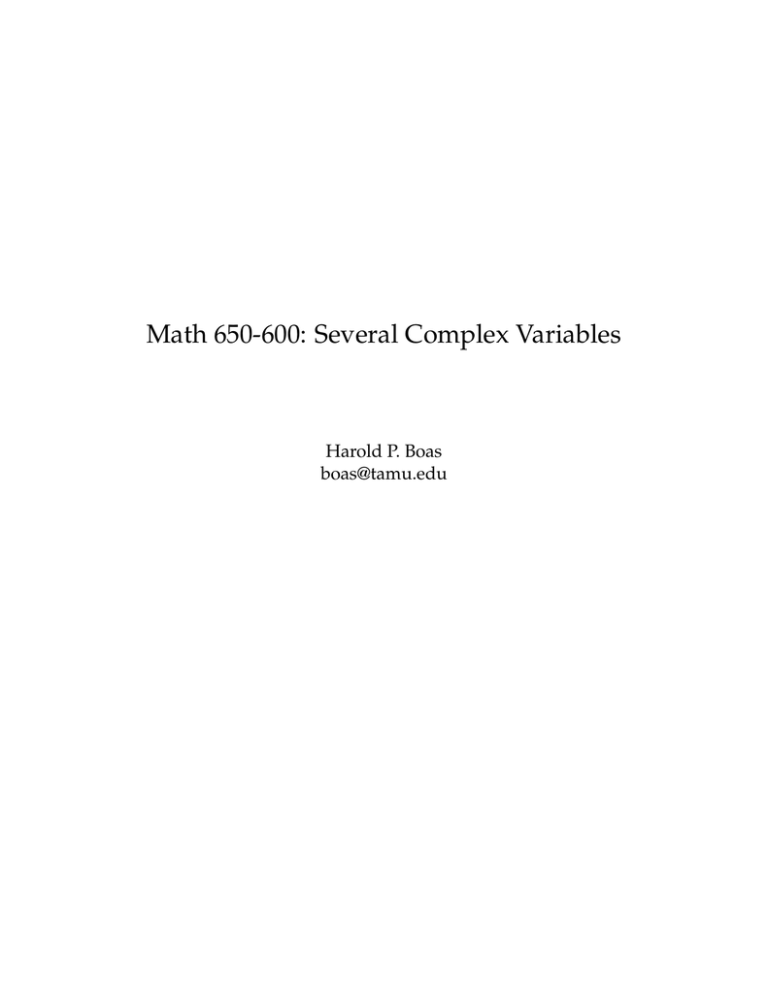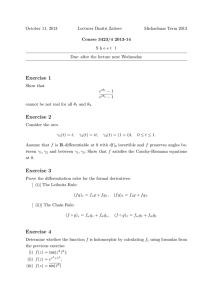Math 650-600: Several Complex Variables Harold P. Boas
advertisement

Math 650-600: Several Complex Variables Harold P. Boas boas@tamu.edu Announcement This week I will be traveling to Washington. Our class will not meet on February 3 (Thursday). Math 650-600 February 1, 2005 — slide #2 Hartogs phenomenon: version 2 Holomorphic functions on a connected Reinhardt domain containing 0 extend to be holomorphic on the logarithmically convex complete envelope. |z2| |z2| |z1| A Hartogs figure |z1| The “Hartogs triangle” |z1 | < |z2 | < 1 Holomorphic functions on the Hartogs triangle do not necessarily extend to a larger open set. Math 650-600 February 1, 2005 — slide #3 Polynomial approximation Mergelyan’s theorem in the plane. If K is compact and C \ K is connected, then every continuous function on K that is holomorphic in the interior of K can be approximated uniformly on K by holomorphic polynomials. Exercise. The conclusion of Mergelyan’s theorem holds on the bidisc in C 2 . Exercise. The conclusion of Mergelyan’s theorem does not hold on the Hartogs triangle in C 2 . Math 650-600 February 1, 2005 — slide #4 The Hartogs phenomenon: version 3 Theorem. Let K be a compact subset of an open set Ω in C n with the property that Ω \ K is connected. If n ≥ 2, then every holomorphic function on Ω \ K extends holomorphically to Ω. Corollary. Singular sets of holomorphic functions propagate out to the boundary. So do zero sets of holomorphic functions. One modern proof of the theorem is based on the solvability of the ∂-equation with compact support when n ≥ 2. Math 650-600 February 1, 2005 — slide #5 Notation In C: z = x + iy, whence dz = dx + i dy and dz = dx − i dy. The exterior derivative ³ ³ ´ ´ ∂f ∂f ∂f ∂f ∂f ∂f d f = ∂x dx + ∂y dy = 12 ∂x − i ∂y dz + 12 ∂x + i ∂y dz, ³ ´ ³ ´ ∂f ∂f ∂f ∂f 1 ∂f 1 ∂f so we define ∂z = 2 ∂x − i ∂y and ∂z = 2 ∂x + i ∂y . Then d f = ∂f ∂z dz + ∂f ∂z dz. ∂f The Cauchy-Riemann equations say that ∂z = 0. ´ ³ ∂f ∂f In Cn , analogously: d f = ∑nj=1 ∂z dz j + ∂z dz j , j j and by definition ∂ f = ∑nj=1 ∂f ∂z j dz j . The Cauchy-Riemann equations say that ∂ f = 0, which is an equivalent way of saying that f is a holomorphic function. Math 650-600 February 1, 2005 — slide #6









